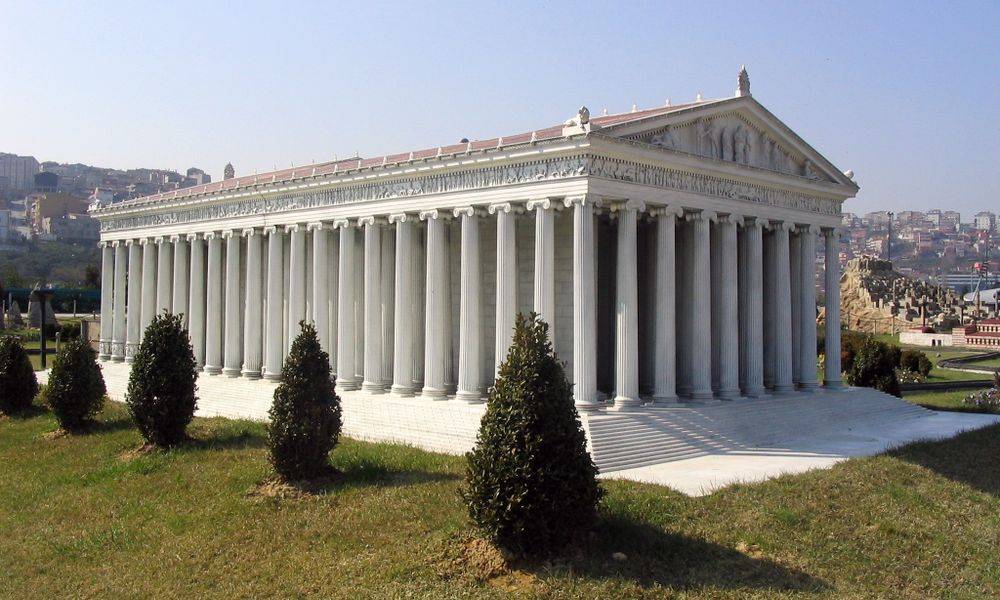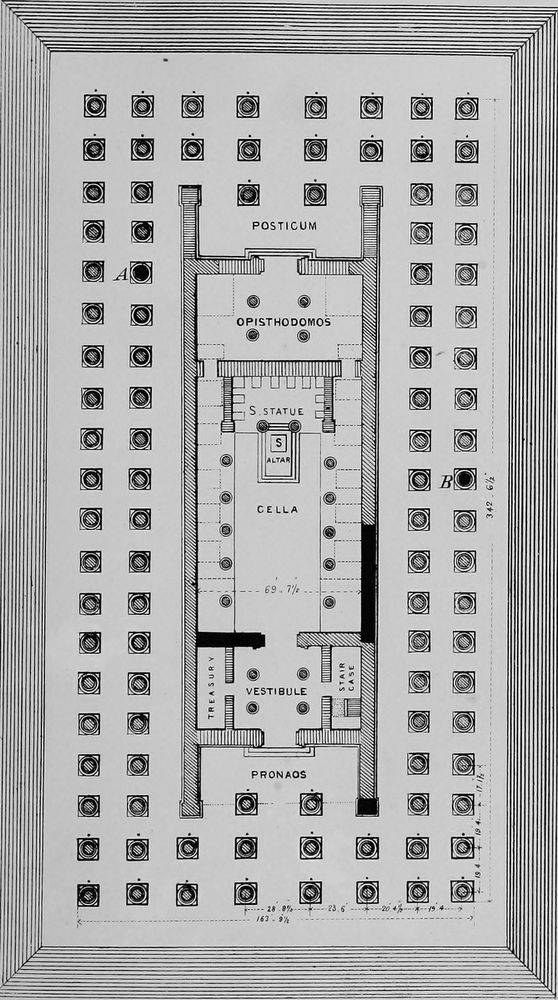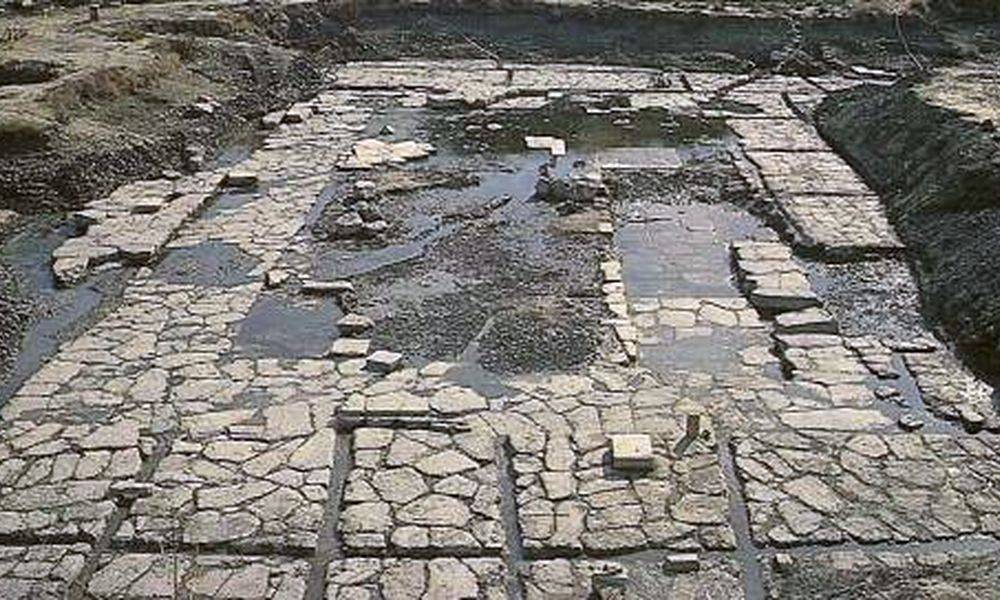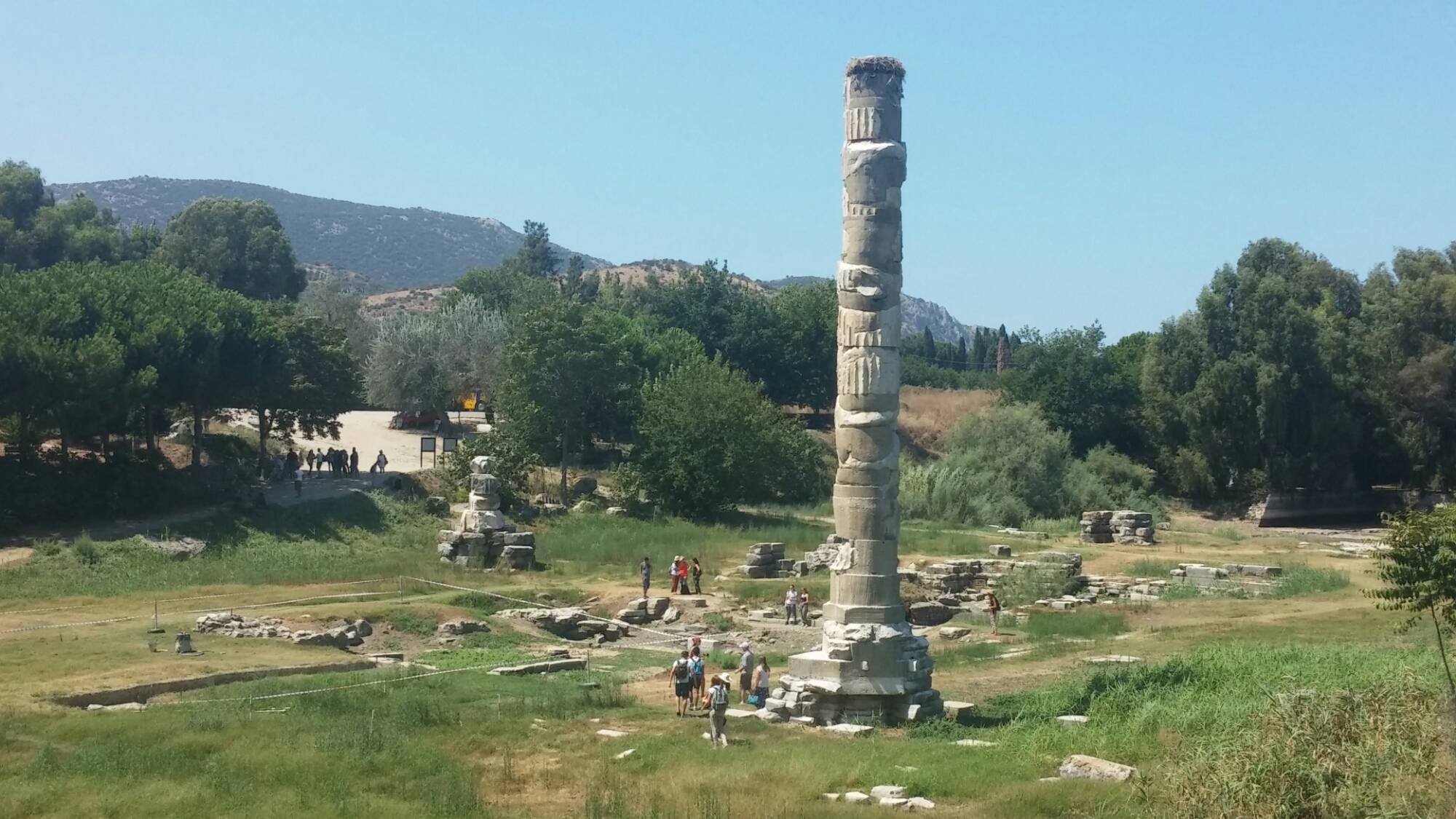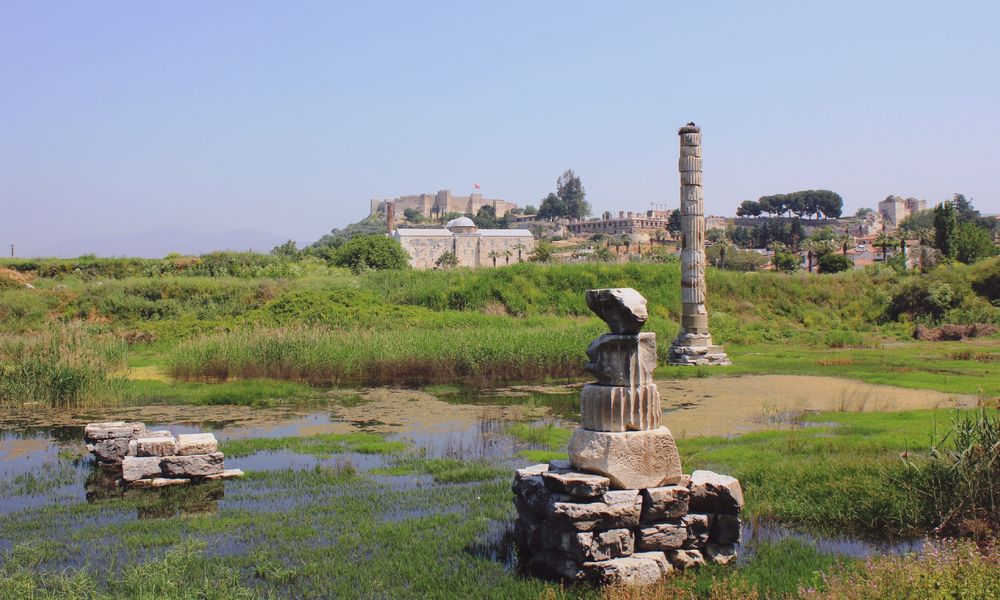The Temple of Artemis, which is also called Artemision, is a sacred building from the Hellenic era built on the remains of older temples. It is located in Selçuk, Turkey, near the Aegean Sea, on a territory formerly dominated by the Greek Empire. This building was placed on the list of the Seven Wonders of the World because of its grandeur and decorations, a reason identical to the Mausoleum of Halicarnassus, another of the seven wonders of the world.
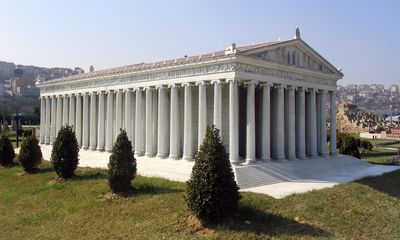
Replica of the temple of Artemis
If the site occupied from the eighth century BC, ie from the Bronze Age, the first occupants scarcely marked their surroundings, leaving little trace of their passages on this part of the Turkish coast of the Aegean Sea. However, it is well known that this place was already home to a first religious site, a temple which is the oldest temple with a row of exterior columns, a style peculiar to Greek architecture and which is called the peripteral style. This temple will be destroyed by a flood (although this point is not definitely excepted by the scientific community) during the 7th century BC. This first temple was replaced in 550 BC by a new temple called "archaic temple", a building financed by King Croesus, credited with an immense fortune. The archaic temple was more imposing and had a double row of columns.
This second temple was deliberately destroyed by a fire in 356 BC and rebuilt under Alexander the Great (the founder of the city of Alexandria in Egypt, where the famous lighthouse of Alexandria was built). It is this new temple, known as "Hellenic" temple, which is used to place in the list of the seven wonders of the World, but the archaic temple was already on lists prior to the canonical list refers to these days).
Documentary sources
The temple of Artemis is known through two elements: The documents testifying to the building and the archaeological remains of the site. As far as documentary sources are concerned, they are essentially confined to Pliny the Elder (Roman author, 23-79 AD), who made a rather poor description of the building. Having lived in the 1st century AD it mixes the observations of the temple with elements of the archaic temple. There is also Vitruvius, a Roman architect of the 1st century BC, and Philo of Byzantium, a Greek scientist from the end of the third century BC. Both give some details about the monument. But modern scientists can not be said to have collapsed under the documentation of the temple, which is rather restricted.
Description
When one speaks of the temple of Artemis of Ephesus, one speaks in fact of three temples which have succeeded each other, historically speaking. But the last two are the ones we know most, and they were quite similar.
Their general forms were classical in Hellenic architecture: A large rectangular room, the largest possible (the Cella) placed on a subgrade to degree and surmounted by a roof with two slopes with a low inclination. The pediments of the roof are therefore triangular. The buildings were both surrounded by two rows of columns, some carved, and they were richly decorated. The two temples, however, had differences, so their descriptions are more detailed in the paragraphs below.
Location of the temple of Artemis
The temple of Artemis was in the town of Selçuk, 7Kms to the east. Selçuk is currently in Turkey, 50Kms south of Izmir. This city was built near the ruins of the ancient city of Ephesus, which is why we are still talking about the temple of Artemis in Ephesus.
What is more surprising is that at the time, that is to say between the 8th and 3rd century BC, Ephesus was a port city, it was on the coast of the Aegean Sea at the mouth of the river Caystre which threw itself into a bay partially blocked by the island of Syria. Since that time the river has deposited its silt in the bay which has permanently sanded itself, moving away the sea. Already in the 8th century the site of the temple was marshy, it was often flooded, it was moreover a motive of work for the architects who had to invent ways to build the temple on these wet soils.
The town of Ephesus was in the vicinity of the Artemisia, but the silting up of the river gradually prevented the ships from arriving, so it was necessary first to build canals and then to move the city one a little further south, a few kilometers away. Thus the temple was more and more isolated, which was rather well seen by those who administered it because the more they moved away from the city, the more independent they were.
Learn more about the Location of the temple of Artemis at Ephèse.
The initial temple : Before the VIIIth century
Little is known about the original temple. At that time, before the eighth century BC, we are in protohistory, a time when the first peoples had organized themselves according to the territory on which they were. On the Turkish coast of the Aegean Sea, the Ionians had a fairly large territory, and extended to the south. The Ionians believed that Apollo and Artemis were born in the mountains of the coast (and not in Delos, as canonically admitted in Greek mythology). They established the site of Ortygia as that of this birth, this place becoming the base geography of the veneration of Artemis. It is of course unknown the reality of the presence of a temple on the site that will later be that of the temple of Artemis but it is known that at that time such temples existed: They were in caves or glades and consisted of the erection of a fairly simple altar. This is rather legendary, but parallel to that we know that it is at the beginning of the first millennium the cult of Artemis at the mouth of the river Caystre. Two ancient authors report that the Amazons, a people of northern Turkey, found a wooden statue representing the goddess Artemis, a statue that would be the first of all those venerated in the temple.
When the Ionians conquered the lagoon of the Cayres, they decided to build a temple at Artemis. It will be a more elaborate temple, with a roof covering the altar, but nothing that can be considered a marvel of the World. In addition there were several altars on the site, they were dedicated to different gods. It is the recent archaeological research which proves it. It is not clear what happened to these original temples, but a legend tells that they were carried away by a flood of the river, which is quite realistic.
The archaic temple : From VIe to IVth century BC
The archaic temple was built on the remains of an even older temple (dating from the 8th century BC) which was demolished by a flood during the VIIth century.
!! A FINIR !!Raisons de la construction du temple archaïque
The new temple built around 550 BC is a decision and funding of Croesus, king of Lydia, who had a modest territory inside Anatolia, now in Turkey. This small kingdom had become prosperous during the 6th century BC, and it was during the reign of Croesus that this kingdom reached its apogee with a territory extending over the greater part of Asia Minor. It should be noted that Caria was a vassal of Lydia. The Caria is known by its king Mausole who built two centuries later the mausoleum of Halicarnassus, another of the seven wonders of the World. It was therefore a vast territory and a great power that Croesus ordered that a temple be erected on this site. The architects were Chersiphron and his son Métagénès, of Crete. Croesus had a statue of Artemis carved in ebony by the sculptor Endoios. Some sources give a reason for the construction of this temple, it could be a reaction against the construction shortly before another temple, in the city of Samos, temple that would have been of great beauty and that would have made Croesus jealous.
Description
Architecturally, the temple followed the usual plans of pre-Hellenic civilization, with a rectangular shape, a steep roof and a double row of columns that allowed the public to pass around the main room, the cella. It was built on a rectangular base surrounded by steps on all sides and had a decorated triangular pediment. The purpose of the double colonnade was to enlarge the building, quite simply, so that it might appear even more majestic. According to Pliny, who lived in the 1st century AD and described it, there were 127 columns, of which the 36 on the facade were carved, including their capitals. One of these columns is in the British Museum, and one can read the inscription "Croesus offered it", a dedication confirmed by Herodotus. Moreover, Theophrastus, a philosopher of ancient Greece born about -371 in Eresós, mentions this temple in his work "History of Plants", he indicates that the doors are made of cypress wood.
When reconstructing the temple one may wonder what techniques were used to climb to nearly 20m high the architraves, these very heavy stones placed at the top of the columns on which the roof rests. The construction technique is unfortunately not known, but historians working on the site will eventually find the answer. The fact remains that an architrave makes about 24 tons, which leaves one to meditate on the capacity of the peoples of the time to build buildings so high.
The decorations
Unlike the Hellenistic temple, the archaic temple did not survive the vagaries of time. However, there are some fragments of friezes that indicate that it was very decorated. The style is the one that was in progress during the Ionic epoch. These decorations were found on the pediment, on the columns, on the lower drums of the columns and on the parapet. It seems that the artists wanted to represent a procession. Some pieces of frieze show cattle and horses. The parapet had to have different subject, which is normal given its long length. There is a procession of chariots as well as Amazons. The presence of Amazons is not so fussy when it is known that it is part of a local myth, and on the other hand that the Amazons were inspired by a people of warriors living in Asia minor some centuries ago.
Its destruction
This archaic temple was destroyed by fire in 356 BC, about the time of the construction of the lighthouse of Alexandria. The fire was voluntary, it was triggered by Erostrate who, according to sources agreeing, would have wanted to make himself famous. Abandoned, Alexander the Great, who founded a Greek Empire dominating the Eastern Mediterranean and Asia Minor, ordered the reconstruction of the temple. It is this one which is called "Hellenistic Temple".
The Hellenistic Temple: From the 3rd century BC to the 5th century AD
Its construction
The Hellenistic temple is the building that replaced the archaic temple in the middle of the 4th century BC. It was ordered by Alexander the Great and built on the same site. Construction costs were borne by various cities in Asia Minor following the fact that the inhabitants of the city of Ephesus refused the funding proposed by Alexander the Great himself. This refusal was motivated by the fear of the Ephesians of seeing a rapid defeat of the Emperor, and therefore of being subsequently regarded as fervent supporters of Alexander. In order to cope with the work, it was necessary to find financing, and a banking service was organized in the temple itself, which means that the temple of Artemis is one of the oldest financial institutions in the temple. world.
Description
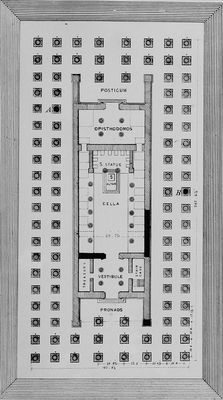
Map of the temple
Its architecture was fairly standard, with a staircase base to climb to the main building. This basement was 13 degrees, forming 13 steps. The main building was 105m long by 55 wide. It was surrounded by two rows of columns 17.65 meters high and as the archaic temple it was richly decorated with sculptures and bas reliefs, some of which were the work of Scopas and others of Praxiteles (a priori the decoration of the altar, for him). The building had a rectangular shape but the exterior walls were not a large rectangle, the two small sides being recessed in the body of the building to form a naos on the entrance side (a kind of porch that is found in architecture Islamic under the name "iwans", see the description of the Taj Mahal for more information), and a posticum on the back side. The great hall was rectangular, but it was divided into three parts. Behind the entrance was a vestibule, the roof of which was supported by four columns, to the right of the stairs, and to the left the treasury of the temple; in the center the room was called the "Cella", a large room containing 10 columns arranged by 5 in which the altar was located; and finally behind the altar was a smaller room called "opisthodome". The altar had a horseshoe-shaped plan with two rows of fine and elongated ionic columns.
The roof had two slopes, they followed the main walls and formed a gable on the front and rear which the sculptors had the task of decorating. The temple had two rows of columns, some of them in the British Museum. They have decorations, scenes of Greek mythology or traditional life. The map opposite was designed by John Turtle Wood himself in his work of 1877, in which he explains his findings. The black parts are those that were still standing at the time of the excavations, in the nineteenth century.
The altar
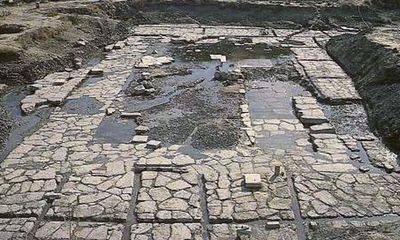
The remains of the altar
The altar was inside Artemision, of course. It was shaped like a horseshoe and measured 39.70m long by 16.67m wide, which, let us admit, is very large. The soil that archaeologists have updated date from the archaic temple and shows a succession of polygonal or trapezoidal slabs, with traces of walls on the south, east and north sides. The Hellenic temple, on the other hand, saw these walls replaced by two rows of columns resting on a base of 3.4m of side and being oriented to the West. This way of rectifying the orientation and the disposition of the altar is an important documentary source to improve the knowledge of the architecture of the monumental altars in the ancient world.
The form of a horseshoe made it possible to create a space in front of the altar in which were all that was necessary for the cult. The altar was slightly elevated, and the priests entered by a graduated ramp. This altar was therefore more than an altar, it was a building in its own right inside the temple, a building isolated from the rest of the temple. It is not an astonishing architecture when one knows that the monument was in fact very frequented, for example by merchants, people delivering their services, the poor seeking refuge or asylum, and so on. Moreover, the fact of separating the spiritual part from the secular part made it possible for the officiants to choose the persons authorized to participate in the rites of worship, and this was an instrument of power which they used frequently.
The decorations
The temple of Artemis possessed a large number of sculptures by famous artists. Scopas and Praxiteles were the most famous contemporary sculptors, but other people had worked there, such as Phidias and Polycletus, who had been from the previous century. Among the most notable statues are those of Zeus made by Myron about 450 BC, but the most important was of course the statue of Artemis. Artemis was represented, accompanied by several symmboles of fertility, her torso, in the form of a fawn, was adorned with several rows of breasts. His head was girded with a sort of basket. This very venerated statue was reproduced several times during antiquity, there are copies that can be seen in the museums of Naples, the Vatican, or even in the Louvre. It should be known that this statue has evolved over time, this description is that of the most recent statue, that which is the best known. But other representations of Artemis had preceded it. The very first had been carved in oak wood, the artistic work was of much lesser quality.
The altar was also richly decorated, the proof comes from two elements dictincts: The documentation that comes to us, on this subject, Strabo and Pausinias, and the archaeological pieces that were used for other uses, once the temple destroy. Here's what strabo says:
the main altar is decorated almost exclusively with works by Praxiteles, and that he has been shown in the temple several pieces of Thrason, the well-known author of Hecateesium and the group of Penelope and old Euryclée at the fountain.
Pausanias describes several bronze statues, including a figuration of the Night, which would have been the work of Rhoikos, one of the architects of the first temple. As far as the archaeological remains are concerned, several stones from the altar have been found, which are now found in different parts of the city: the theater, the Basilica of Saint John and the Isa Bey mosque. Most of these blocks are exhibited today at the Ephesus Museum and at the Ephesos Museum in Vienna.
The main building was surrounded by columns, these columns were decorated with mythological scenes or scenes of everyday life. At the corners of the temple, on the back, the architects had placed quadriges (chariots with 2 wheels and 4 horses), imposing statues intended to increase the impression of power that lavished this place. The pediment of the temple was probably very decorated, but there are no traces of it today.
Its history
The temple of Artemis will be plundered by Nero, most of the works of art being recovered and brought to Rome under his reign (54 to 68 AD), then it will be attacked by the Goths in 265. It is not known if it is' is this event that made it unusable or was still used later, but it is found at the edict of Theodosius I in 391, whereby Christianity is put forward in relation to paganism. Besides, the temple was damaged by earthquakes, and was put down in 401.
From there and as often, the ruins of the temple were used for the construction of other buildings, for example for the church of St. John and that of St. Sophia of Constantinople (Pillars of St. Sophia come from the temple of Artemis).
Role of the temple
The temple was also a meeting place, a kind of forum that is not open to the sky. It housed especially merchants and probably various other trades. The cult of Artemis was relatively important at the time, so the temple regularly received offerings, which allowed modern archaeologists to retrieve jewelry dedicated to Artemis on the site. Moreover, as early as the 6th century BC, this temple also had a protective role insofar as every person there was protected, a little like what was done among Christians at the time of the truce of God, a papal act signed in the town of Toulouges protecting anyone within 30m of a church (which explains the shape of some villages in the south of France, circular shape around the church).
Its influence in the world
The temple, in addition to being a place of veneration, was also a political entity in its own right. It was funded and located somewhat apart from the city of Ephesus and acquired privileges which gave it a certain degree of autonomy and thus developed in the known world. On all the coasts of the Aegean Sea, but also at the end of Anatolia, in the Mediterranean basin, on the Iberian peninsula, a special cult was dedicated to the Ephesian Artemis, or, as it was later called, to Diana of Ephesus. It was a goddess quite apart, it had a representation distinct from the other Artemis, its attributes were also different. The high priest of the temple called megabyse had powers equivalent to those of the magistrates of Ephesus, at least at the time of his apogee, and this power was respected by the various government of the city, the civilizations which possessed it. Thus the Lydians, the Persians, the Athenians, and the Spartans did not touch the temple of Ephesus, and even Alexander the Great did not impose his conditions on it. On the contrary, it was he who proposed to finance his reconstruction, after the fire of the archaic temple took place (which was refused by the inhabitants who sought another means of financing leading to the banking system below).
Even the Roman emperors wishing to force the people to venerate them did not succeed in replacing the cult of Artemis at Ephesus. It was only later, at the time of the fall of the Empire, that this cult would disappear, and also the material one of the temple itself.
The banking activity of the temple
It's fun enough to think about it now but the Temple of Artemis is probably one of the oldest banking institutions in the world. At the time of its reconstruction in the middle of the 4th century BC it was the Emperor Alexander the Great who wanted to finance it but was refused by the inhabitants of Ephesus on the grounds that they were afraid that the emperor would not succeed to remain in power, and consequently to be associated with his image in case this happens. To avoid this the Ephesians preferred to find autonomous financing and had to pay for various cities in the neighborhoods, but it is a simple principle that will allow the complete financing, that of the bank.
It was in the very heart of the temple that a place of exchange and creativity was created, innovative notions that made it possible to obtain funds. This bank before the hour stayed after the work ended, allowing it to evolve.
Archaeological discovery: 19th century
After its destruction the Artemision was abandoned definitively, the stones having been used for the construction of other buildings of which the church St John and St. Sophia of Constantinople. Little by little the site, of a very flat and humid nature, turned into a swamp and it was in this state that the site was rediscovered during excavations organized in the nineteenth century.
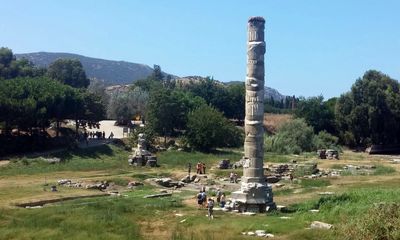
The archaeological site
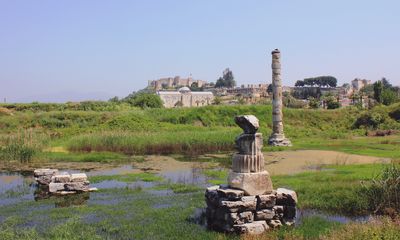
The archaeological site
It was an Englishman, John Turtle Wood, who invented the site. Wood was an engineer and in 1859 he was given the task of building all the railway stations from Smyrna to Aydin. On the spot he was passionate about archeology, of which he knew nothing before leaving, and set out to find the ruins of the temple of Artemis. For this, he conjectured that the temple should be on a low plateau on the outskirts of the city of Ephesus. Having identified such a place in 1963, he asked the British Museum to obtain permission to carry out excavations and, better still, to recover his finds and expose them to the London Museum. Thus he was able to have the works of extravation carried out by workers of the railway line, but without success, and this in spite of researches which lasted a year. In 1964 he asked for an exceptional funding from the British Museum to pursue his research, with his own funds arriving at the end, which was granted to him. It must be said that at about the same time another Englishman, Charles Newton, had just discovered the mausoleum of Halicarnassus, another of the seven wonders of the world near Bodrum, and to concentrate at the British Museum the vestiges of two such important sites justified this comparatively small exceptional funding compared to the potential gains to be made.
In 1866 the excavations continued but led to the exclusion of the odeon, certainly an archaeological piece of great importance but which was not the temple itself. John Turtle Wood changed his way of working. He went to the railway yard, an obligation he had abandoned, and delegated the excavations to a foreman who was then running a team of 40 workers. In 1867 they attacked the site surrounding the theater and cleared numerous archaeological elements, and in 1868 he cleared a road that led to a branch. He chose to continue to clear a branch which led him to a stoa, it is a meeting building covered and sheltered from the wind by a high wall, a little like a corridor one side of which would be made of a long colonnade .
But by the end of 1869 all this work ruined his finances and he returned to the United Kingdom to obtain new financing. This time with less enthusiasm he was able to get enough money to return to the site and finance the rest of the work to clear the other roads, which led him to other ruins (especially tombs). In a field of olive trees he found, at a depth of 6 meters, the basement of a temple with Latin and Greek inscriptions. This temple was the temple of Artemis, it was discovered on December 31, 1869.
Wood later returned to England and the site was closed until a second excavation campaign was undertaken in 1905 by Hogarth and Henderson. It was from this period that the three successive temples were discovered.
In fact, when Wood finally fell on the base of the temple, he was mistaken: What he had discovered was the Naïskos (sanctuary) of the archaic temple, but that he will never know, it is the recent excavations which allow us to say it.
Finally, a third excavation campaign was initiated in 1965 and continues today, it is undertaken by the Institute of Archeology in Vienna. But it is difficult to do because of the periodic rise of the ground water, as the difficulties encountered by archaeologists today are the same as those encountered by their predecessors.
See also:





